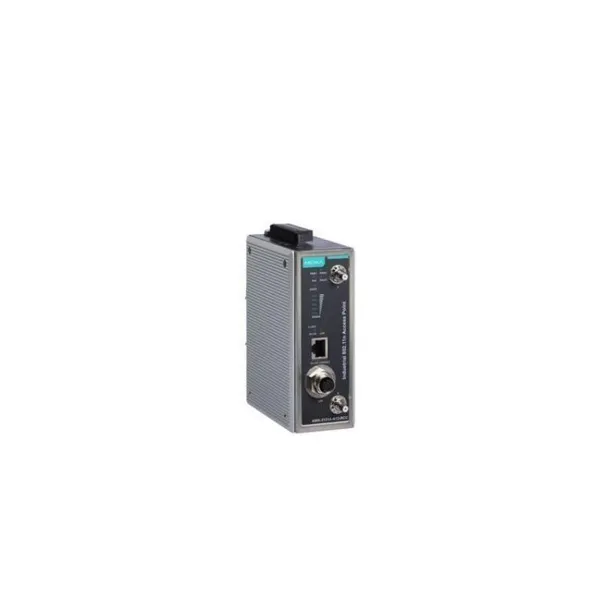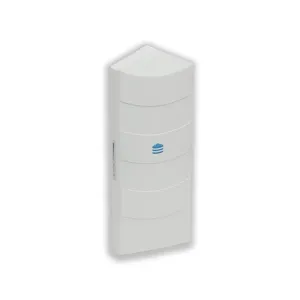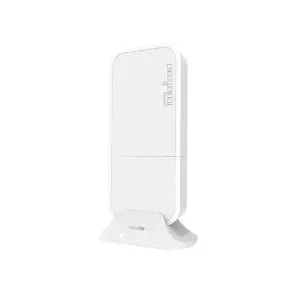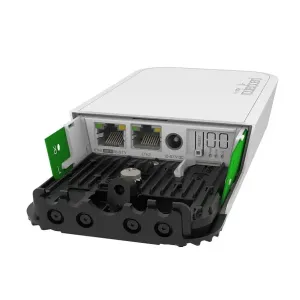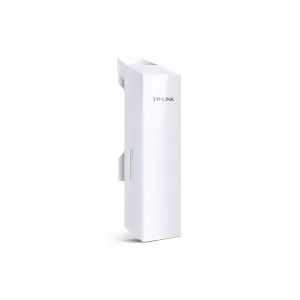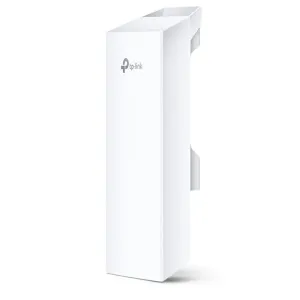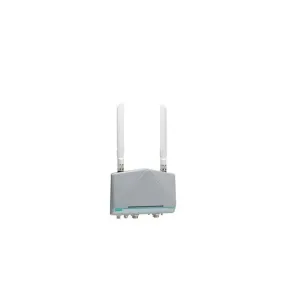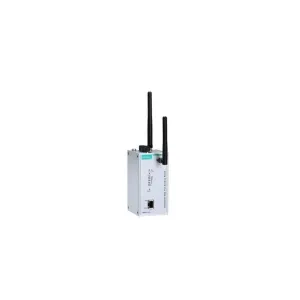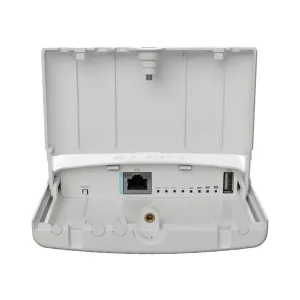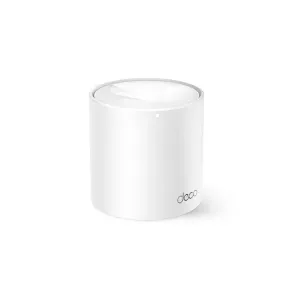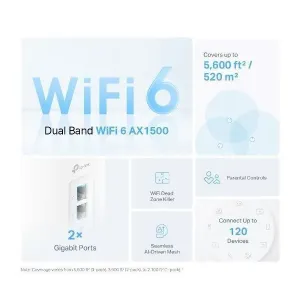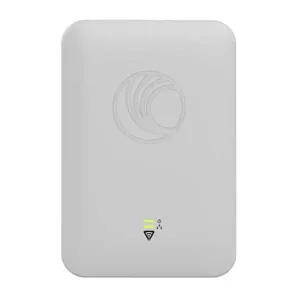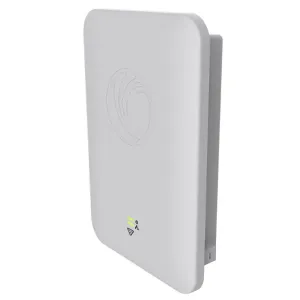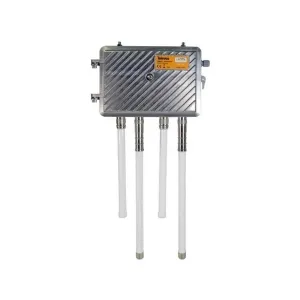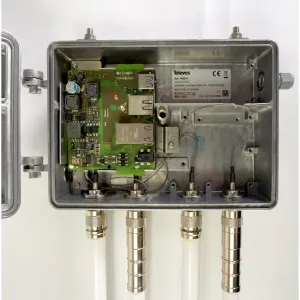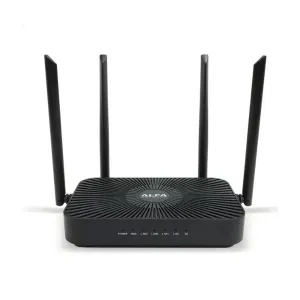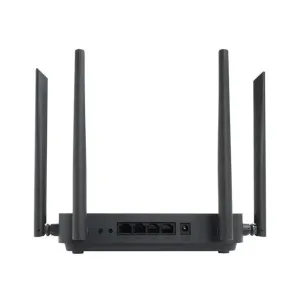MOXA – AWK-3131A-M12-RTG-EU-T – 802.11n-Eisenbahn-Zugangspunkt, M12, EU-Band
inkl. 19 % MwSt. zzgl. Versandkosten
802.11n Railway Onboard Indoor Single Radio Access Point/Client, M12, EU-Band, IP30, -40 bis 75°C Betriebstemperatur WLAN-Schnittstelle WLAN-Standards: 802.11a/b/g/n; 802.11i Wireless Security Modulationsart: DSSS OFDM 802.11b: CCK @ 11/5.5 Mbps…
| Artikelnr. | 385470 |
|---|---|
| EAN | 4251876808337 |
| MPN | AWK-3131A-M12-RTG-EU-T |
| Kategorien | WLAN, Access Points & Verstärker, Netzwerk |
| Schlagwörter | Access Point, mehrfarbig, MOXA, Netzwerk |
802.11n Railway Onboard Indoor Single Radio Access Point/Client, M12, EU-Band, IP30, -40 bis 75°C Betriebstemperatur
WLAN-Schnittstelle
WLAN-Standards: 802.11a/b/g/n; 802.11i Wireless Security
Modulationsart:
DSSS
OFDM
802.11b: CCK @ 11/5.5 Mbps
802.11b: DQPSK @ 2 Mbit/s
802.11b: DBPSK @ 1 Mbit/s
802.11a/g: 64QAM @ 54/48 Mbit/s
802.11a/g: 16QAM @ 36/24 Mbit/s
802.11a/g: QPSK @ 18/12 Mbit/s
802.11a/g: BPSK @ 9/6 Mbit/s
802.11n: 64QAM @ 300 Mbit/s bis BPSK @ 6,5 Mbit/s
Frequenzband für EU (20 MHz Betriebskanäle):
2,412 bis 2,472 GHz (13 Kanäle)
5,180 bis 5,240 GHz (4 Kanäle)
5,260 bis 5,320 GHz (4 Kanäle)
5,500 bis 5.700 GHz (11 Kanäle)
Drahtlose Sicherheit:
SSID-Broadcast aktivieren/deaktivieren
WEP-Verschlüsselung (64-Bit und 128-Bit)
WPA/WPA2-Personal
WPA/WPA2-Enterprise (IEEE 802.1X/RADIUS, TKIP, AES)
Übertragungsrate:
802.11b: 1 bis 11 Mbps
802.11a/g: 6 bis 54 Mbps
802.11n: 6,5 bis 300 Mbps
Sendeleistung für 802.11a:
23±1.5 dBm @ 6 bis 24 Mbps
21±1.5 dBm @ 36 Mbps
20±1.5 dBm @ 48 Mbps
18±1.5 dBm @ 54 Mbps
Sendeleistung für 802.11n (5 GHz):
23±1.5 dBm @ MCS0 20 MHz
20±1.5 dBm @ MCS1 20 MHz
20±1.5 dBm @ MCS2 20 MHz
20±1.5 dBm @ MCS3 20 MHz
19±1.5 dBm @ MCS4 20 MHz
18±1.5 dBm @ MCS5 20 MHz
18±1.5 dBm @ MCS6 20 MHz
18±1.5 dBm @ MCS7 20 MHz
23±1.5 dBm @ MCS8 20 MHz
20±1.5 dBm @ MCS9 20 MHz
20±1.5 dBm @ MCS10 20 MHz
20±1.5 dBm @ MCS11 20 MHz
19±1.5 dBm @ MCS12 20 MHz
19±1.5 dBm @ MCS13 20 MHz
18±1.5 dBm @ MCS14 20 MHz
18±1.5 dBm @ MCS15 20 MHz
23±1.5 dBm @ MCS0 40 MHz
20±1.5 dBm @ MCS1 40 MHz
20±1.5 dBm @ MCS2 40 MHz
20±1.5 dBm @ MCS3 40 MHz
19±1.5 dBm @ MCS4 40 MHz
18±1.5 dBm @ MCS5 40 MHz
18±1.5 dBm @ MCS6 40 MHz
18±1.5 dBm @ MCS7 40 MHz
23±1.5 dBm @ MCS8 40 MHz
20±1.5 dBm @ MCS9 40 MHz
20±1.5 dBm @ MCS10 40 MHz
20±1.5 dBm @ MCS11 40 MHz
19±1.5 dBm @ MCS12 40 MHz
19±1.5 dBm @ MCS13 40 MHz
18±1.5 dBm @ MCS14 40 MHz
18±1.5 dBm @ MCS15 40 MHz
Sendeleistung für 802.11b:
26±1.5 dBm @ 1 Mbps
26±1.5 dBm @ 2 Mbps
26±1.5 dBm @ 5.5 Mbps
25±1.5 dBm @ 11 Mbps
Sendeleistung für 802.11g:
23±1.5 dBm @ 6 bis 24 Mbps
21±1.5 dBm @ 36 Mbps
19±1.5 dBm @ 48 Mbps
18±1.5 dBm @ 54 Mbps
Sendeleistung für 802.11n (2,4 GHz):
23±1,5 dBm @ MCS0 20 MHz
21±1,5 dBm @ MCS1 20 MHz
21±1,5 dBm @ MCS2 20 MHz
21±1.5 dBm @ MCS3 20 MHz
20±1.5 dBm @ MCS4 20 MHz
19±1.5 dBm @ MCS5 20 MHz
18±1.5 dBm @ MCS6 20 MHz
18±1.5 dBm @ MCS7 20 MHz
23±1.5 dBm @ MCS8 20 MHz
21±1.5 dBm @ MCS9 20 MHz
21±1.5 dBm @ MCS10 20 MHz
21±1.5 dBm @ MCS11 20 MHz
20±1.5 dBm @ MCS12 20 MHz
19±1.5 dBm @ MCS13 20 MHz
18±1.5 dBm @ MCS14 20 MHz
18±1.5 dBm @ MCS15 20 MHz
23±1.5 dBm @ MCS0 40 MHz
20±1.5 dBm @ MCS1 40 MHz
20±1.5 dBm @ MCS2 40 MHz
20±1,5 dBm @ MCS3 40 MHz
19±1,5 dBm @ MCS4 40 MHz
19±1,5 dBm @ MCS5 40 MHz
18±1,5 dBm @ MCS6 40 MHz
17±1,5 dBm @ MCS7 40 MHz
23±1.5 dBm @ MCS8 40 MHz
20±1,5 dBm @ MCS9 40 MHz
20±1,5 dBm @ MCS10 40 MHz
20±1,5 dBm @ MCS11 40 MHz
20±1,5 dBm @ MCS12 40 MHz
19±1.5 dBm @ MCS13 40 MHz
18±1.5 dBm @ MCS14 40 MHz
17±1.5 dBm @ MCS15 40 MHz
Empfangsempfindlichkeit für 802.11a (gemessen bei 5.680 GHz):
Typ. -90 @ 6 Mbps
Typ. -88 @ 9 Mbps
Typ. -88 @ 12 Mbps
Typ. -85 @ 18 Mbps
Typ. -81 @ 24 Mbps
Typ. -78 @ 36 Mbps
Typ. -74 @ 48 Mbit/s
Typ. -74 @ 54 Mbps
Empfangsempfindlichkeit für 802.11n (5 GHz; gemessen bei 5,680 GHz):
Typ. -88 dBm @ MCS0 20 MHz
Typ. -85 dBm @ MCS1 20 MHz
Typ. -82 dBm @ MCS2 20 MHz
Typ. -79 dBm @ MCS3 20 MHz
Typ. -76 dBm @ MCS4 20 MHz
Typ. -71 dBm @ MCS5 20 MHz
Typ. -70 dBm @ MCS6 20 MHz
Typ. -69 dBm @ MCS7 20 MHz
Typ. -95 dBm @ MCS8 20 MHz
Typ. -91 dBm @ MCS9 20 MHz
Typ. -87 dBm @ MCS10 20 MHz
Typ. -80 dBm @ MCS11 20 MHz
Typ. -78 dBm @ MCS12 20 MHz
Typ. -74 dBm @ MCS13 20 MHz
Typ. -72 dBm @ MCS14 20 MHz
Typ. -71 dBm @ MCS15 20 MHz
Typ. -84 dBm @ MCS0 40 MHz
Typ. -81 dBm @ MCS1 40 MHz
Typ. -77 dBm @ MCS2 40 MHz
Typ. -75 dBm @ MCS3 40 MHz
Typ. -71 dBm @ MCS4 40 MHz
Typ. -67 dBm @ MCS5 40 MHz
Typ. -64 dBm @ MCS6 40 MHz
Typ. -63 dBm @ MCS7 40 MHz
Typ. -90 dBm @ MCS8 40 MHz
Typ. -85 dBm @ MCS9 40 MHz
Typ. -82 dBm @ MCS10 40 MHz
Typ. -81 dBm @ MCS11 40 MHz
Typ. -77 dBm @ MCS12 40 MHz
Typ. -73 dBm @ MCS13 40 MHz
Typ. -71 dBm @ MCS14 40 MHz
Typ. -68 dBm @ MCS15 40 MHz
Empfangsempfindlichkeit für 802.11b (gemessen bei 2,437 GHz):
Typ. -93 dBm @ 1 Mbps
Typ. -93 dBm @ 2 Mbps
Typ. -93 dBm @ 5,5 Mbps
Typ. -88 dBm @ 11 Mbps
Empfangsempfindlichkeit für 802.11g (gemessen bei 2,437 GHz):
Typ. -88 dBm bei 6 Mbit/s
Typ. -86 dBm @ 9 Mbps
Typ. -85 dBm @ 12 Mbps
Typ. -85 dBm @ 18 Mbps
Typ. -85 dBm @ 24 Mbps
Typ. -82 dBm @ 36 Mbps
Typ. -78 dBm @ 48 Mbps
Typ. -74 dBm @ 54 Mbps
Empfangsempfindlichkeit für 802.11n (2,4 GHz; gemessen bei 2,437 GHz):
Typ. -89 dBm @ MCS0 20 MHz
Typ. -85 dBm @ MCS1 20 MHz
Typ. -85 dBm @ MCS2 20 MHz
Typ. -82 dBm @ MCS3 20 MHz
Typ. -78 dBm @ MCS4 20 MHz
Typ. -74 dBm @ MCS5 20 MHz
Typ. -72 dBm @ MCS6 20 MHz
Typ. -70 dBm @ MCS7 20 MHz
Typ. -95 dBm @ MCS8 20 MHz
Typ. -90 dBm @ MCS9 20 MHz
Typ. -87 dBm @ MCS10 20 MHz
Typ. -83 dBm @ MCS11 20 MHz
Typ. -80 dBm @ MCS12 20 MHz
Typ. -74 dBm @ MCS13 20 MHz
Typ. -71 dBm @ MCS14 20 MHz
Typ. -69 dBm @ MCS15 20 MHz
Typ. -87 dBm @ MCS0 40 MHz
Typ. -83 dBm @ MCS1 40 MHz
Typ. -83 dBm @ MCS2 40 MHz
Typ. -80 dBm @ MCS3 40 MHz
Typ. -76 dBm @ MCS4 40 MHz
Typ. -73 dBm @ MCS5 40 MHz
Typ. -69 dBm @ MCS6 40 MHz
Typ. -67 dBm @ MCS7 40 MHz
Typ. -93 dBm @ MCS8 40 MHz
Typ. -88 dBm @ MCS9 40 MHz
Typ. -85 dBm @ MCS10 40 MHz
Typ. -82 dBm @ MCS11 40 MHz
Typ. -78 dBm @ MCS12 40 MHz
Typ. -73 dBm @ MCS13 40 MHz
Typ. -69 dBm @ MCS14 40 MHz
Typ. -67 dBm @ MCS15 40 MHz
WLAN-Betriebsart: Access Point, Client, Client-Router, Sniffer
Antennenanschlüsse: QMA
Ethernet-Schnittstelle
PoE-Ports (10/100BaseT(X), M12 D-kodierte 4-polige Buchse): 1, nur AWK-3131A-M12-RTG
Standards:
– IEEE 802.3 für 10BaseT
– IEEE 802.3u für 100BaseT(X)
– IEEE 802.3af für PoE
– IEEE 802.1Q für VLAN-Tagging
10/100BaseT(X) Ports (M12 D-kodierte 4-polige Buchse): 1, 10/100BaseT(X) mit automatischer Aushandlung der Geschwindigkeit, F/H-Duplex-Modus und automatischer MDI/MDI-X-Verbindung (nur AWK-3131A-M12-RTG)
100BaseFX-Ports (Singlemode-SC-Anschluss): 1, nur AWK-3131A-SSC-RTG
Ethernet-Softwarefunktionen
Verwaltung:
– Allgemein: Proxy ARP, DNS, HTTP, HTTPS, IP, ICMP, SNTP, TCP, UDP, RADIUS, SNMP, PPPoE, DHCP
– Nur AP: ARP, BOOTP, DHCP, STP/RSTP (IEEE 802.1D/w)
Sicherheit: RADIUS
Firewall
Filter: MAC/IP-Protokoll/Port-basiert
Serielle Schnittstelle
Konsolenanschluss: RS-232 (RJ45-Typ)
LED-Schnittstelle
LED-Anzeigen: PWR1, PWR2, PoE*, FAULT, STATE, SIGNAL, CLIENT, WLAN, LAN (nur AWK-3131A-M12-RTG),100M (nur AWK-3131A-SSC-RTG)
*PoE ist nur für AWK-3131A-M12-RTG verfügbar
Eingangs-/Ausgangsschnittstelle
Digitaleingänge: 2
– +13 bis +30 V für Zustand 1
– +3 bis -30 V für Zustand 0
Max. Eingangsstrom: 8 mA
Alarmkontaktkanäle: Relaisausgang mit einer Strombelastbarkeit von 1 A @ 24 VDC
Tasten: Reset-Taste
Physikalische Eigenschaften
Gehäuse: Metall
IP-Schutzart: IP30
Abmessungen: 52,9 x 151,9 x 127,4 mm (2,08 x 5,98 x 5,02 in)
Gewicht: 850 g (1,87 lb)
Montage: DIN-Schienenmontage, Wandmontage (mit optionalem Kit)
Leistungsparameter
Eingangsstrom:
-AWK-3131A-M12-RTG: 0,85 A @ 12 VDC, 0,22 A @ 48 VDC
-AWK-3131A-SSC-RTG: 1,0 A @ 12 VDC, 0.27 A @ 48 VDC
Eingangsspannung: 12 bis 48 VDC, redundante Doppeleingänge, 48 VDC Power-over-Ethernet
Stromanschluss: 1 abnehmbare 10-Kontakt-Klemmenleiste(n)
Leistungsaufnahme:
-AWK-3131A-M12-RTG: Maximal 10,5 W
-AWK-3131A-SSC-RTG: Maximal 13 W
Verpolungsschutz: Unterstützt
Umgebungsgrenzwerte
Betriebstemperatur:
– Wide Temp. Modelle: -40 bis 75°C (-40 bis 167°F)
Lagertemperatur (inklusive Verpackung): -40 bis 85°C (-40 bis 185°F)
Relative Luftfeuchtigkeit der Umgebung: 5 bis 95% (nicht kondensierend)
Normen und Zertifizierungen
EMC: EN 61000-6-2/-6-4
EMI: CISPR 32, FCC Teil 15B Klasse B
EMS:
– IEC 61000-4-2 ESD: Kontakt: 8 kV; Luft: 15 kV
– IEC 61000-4-3 RS: 80 MHz bis 1 GHz: 20 V/m
– IEC 61000-4-4 EFT: Leistung: 2 kV; Signal: 2 kV
– IEC 61000-4-5 Surge: Leistung: 2 kV; Signal: 2 kV
– IEC 61000-4-6 CS: 10 V
– IEC 61000-4-8
Eisenbahn: EN 50155, EN 50121-4
Eisenbahn-Brandschutz: EN 45545-2
Funk: EN 301 489-1/17, EN 300 328, EN 301 893, MIC, FCC ID SLE-WAPN008, SRRC, NCC, IDA
Sicherheit: UL 60950-1, IEC 60950-1, EN 60950-1 (LVD)
MTBF
Zeit:
– AWK-3131A-M12-RTG: 552.454 Stunden
– AWK-3131A-SSC-RTG: 528.478 Stunden
Normen: Telcordia SR332
| Gewicht | 1,0 kg |
|---|---|
| Größe | 17 × 15 × 7 cm |
| Frequenzband | Dual-Band |
| WLAN Frequenz | 2,4 GHz, 5 GHz |
| Produkttyp | Access Point |
| Farbe | mehrfarbig |
Produktsicherheit
Herstellerinformationen
VARIA System GmbH
Dr.-Salvador-Allende-Straße 191
09119 Chemnitz
DE - Deutschland
E-Mail: info@varia.org
Verantwortliche Person in der EU
VARIA System GmbH
Dr.-Salvador-Allende-Straße 191
09119 Chemnitz
DE - Deutschland
E-Mail: info@varia.org
Moxa Inc ist einer der drei größten Hersteller von Netzwerklösungen für die Industrieautomation weltweit. Die Produkte von Moxa sind von zuverlässiger Qualität und werden in den verschiedensten Branchen eingesetzt. Die Produkte sind RoHS & WEEE konform.

